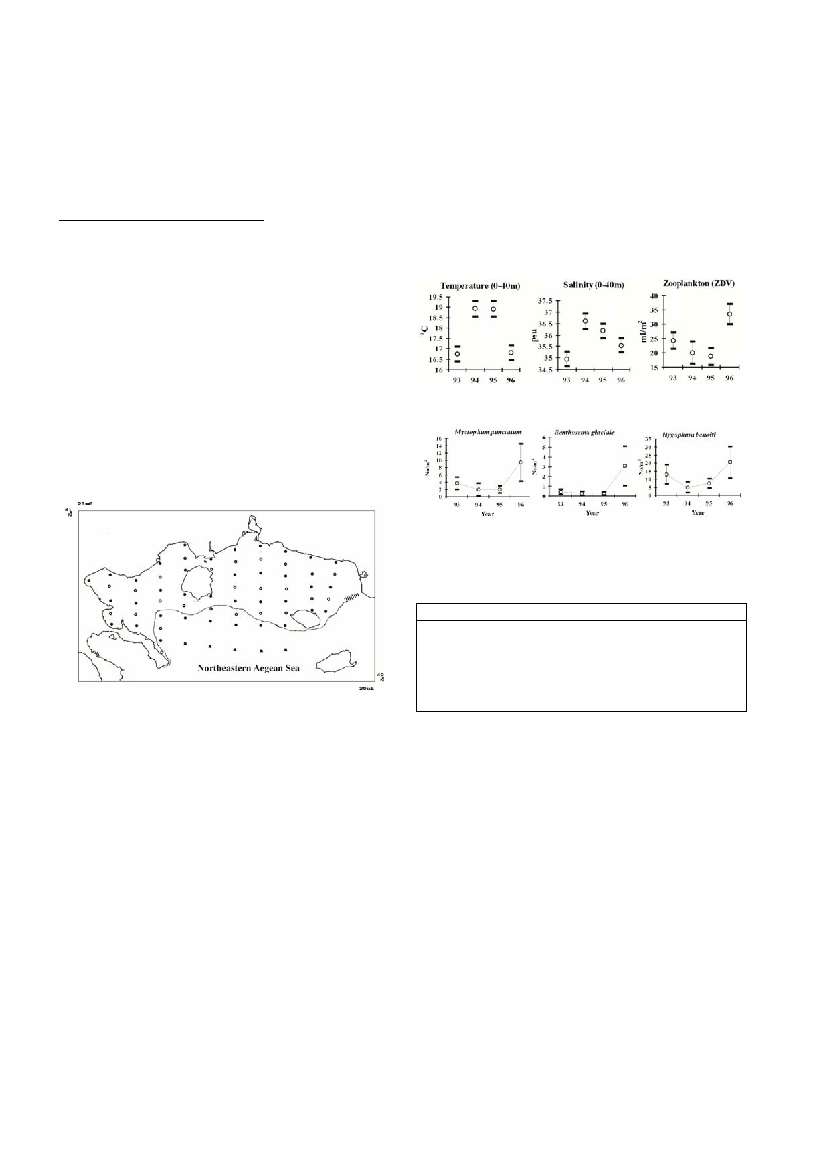Rapp. Comm. int. Mer Médit., 36,2001
325
Introduction
It has been suggested that small-sized pelagics, such as anchovies,
respond quickly to variations in the adult feeding environment by
adjusting their egg production parameters –batch fecundity and inter-
spawning interval (1). This can be re?ected by the abundance of their
spawn in the plankton.
In the present communication we present evidence that planktivo-
rous laternfishes, which are also small-sized fishes, present increased
ichthyoplankton abundance when waters are richer in zooplankton.
Materials and methods
Larval fishes were collected during four surveys carried out in 7-11
June 1993, 19-23 June 1994, 15-22 June 1995 and in 6-14 June 1996
in the NE Aegean Sea (Eastern Mediterranean). Stations were located
at approximately 5 (1993 and 1995) or 10 (1994 and 1996) nautical-
mile intervals on transects running parallel to lines of longitude and
spaced 10 nautical miles apart (Fig. 1). In 1996, five additional off-
shore stations were sampled. At each station, a vertical profile of salin-
ity and temperature was made using a Seabird 19 CTD.
Ichthyoplankton sampling gear and methodology, as well as laborato-
ry analysis of samples, are described in (2).
Fig.1. Map of the study area showing the location of sampling
stations.
Black cycles = stations sampled during all years. Open cycles = sta-
tions sampled only in 1993 and 1995. Crosses = offshore stations
sampled in 1996.
To provide a more powerful test for among years differences in the
abundance of larvae, we bootstrapped 95% confidence intervals on
resulting means (3). A preliminary analysis showed that interannual
differences in sampling intensity and the five additional offshore sta-
tions of 1996 (see above) did not affect results.
Results and discussion
The upper water column was generally cooler and less saline in
1993 and 1996 than in 1994 and 1995 (Fig.2). Mean zooplankton dis-
placement volume (ZDV), measured from the catch of the 0.250-mm
mesh net, was higher in the “cool” years (1993 and 1996), especially
in 1996 when it was almost twice as much than in the “warm” years
(1994 and 1995) (Fig.2).
A total of seven species of Myctophidae were identified in the
ichthyoplankton collections (Table 1). Most of them (B. glaciale,
C.maderensis, M. punctatum, H. benoiti, L. crocodilus) were more
abundant in 1996 (Table 1, Fig. 3). M. punctatumandH. benoitihad
also relatively high abundance in 1993 (Fig. 3).
This pattern of interannual variation in the abundance of myctophid
larvae was similar to larvae of the anchovy, which were more abundant
in June 1993 and June 1996 (4). Interannual differences in the envi-
ronmental conditions observed during June in the NE Aegean Sea
were attributable to cold and wet winters in 1993 and 1996 (4).
Fig. 2. Mean values and 95% confidence intervals for selected
environmental parameters
Fig. 3. Mean abundance and 95% bootstrapped confidence
intervals for myctophid larval species exemplifying interannu-
al differences.
Table 1. NE Aegean Sea. Mean abundance (larvae/m
2
) of myc-
tophid larvae in June 1993, 1994, 1995 and 1996.
Asterisks denote non-overlapping 95% bootstrapped confidence
intervals between 1996 and 1994-1995.
In a way similar to short-term within-year changes, interannual vari-
ability in the abundance of larval fishes in the plankton, particularly
during the transitional period of spring-early summer, may re?ect vari-
ability in physical processes and be particularly useful in highlighting
reproductive adaptations of species to the pelagic environment (5).
References
1. Somarakis S., Maraveya E. and Tsimenides N., 2000. Multispecies
ichthyoplankton associations in epipelagic species : is there any intrinsic
adaptive function? Belg.J. Zool., 130 (Suppl. 1) : 125-129.
2.Somarakis S., Catalano B. and Tsimenides N., 1998. Catchability and
retention of larval European anchovy,Engraulis encrasicolus, with bongo
nets.Fish. Bull., 96 : 917-925.
3.Thorrold S.R. and McKinnon A.D., 1995. Response of larval fish
assemblages to a riverine plume in coastal waters of the central Great
Barrier Reef lagoon. Limnol. Oceanogr., 40(1) : 177-181.
4.Somarakis S., 1999. Ichthyoplankton of the Northeastern Aegean Sea
with emphasis on anchovy,Engraulis encrasicolus(Linnaeus, 1758)
(June 1993, 1994, 1995, 1996). Ph. D. Thesis, University of Crete.
5.Cowen R.K., Hare J.A. and Fahay M.P., 1993. Beyond hydrography.
COVARIATION IN MEAN ABUNDANCE OF LARVAL MYCTOPHIDS
AND ZOOPLANKTON BIOVOLUMES IN THE NE AEGEAN SEA
Stylianos Somarakis*, Eleni Maraveya
Institute of Marine Biology of Crete, Iraklion, Crete, Greece - somarak@imbc.gr
Abstract
Species composition and abundance of mesopelagic larvae during June 1993, 1994, 1995 and 1996 are presented in waters of the
northeastern Aegean Sea (Eastern Mediterranean). Significant interannual differences were found that appeared to be associated with
differences in environmental conditions. In June 1996 waters were colder, less saline and richer in zooplankton. Larvae of laternfishes were
significantly more abundant in 1996.
Keywords : Ichthyoplankton, Aegean Sea
Species
1993199419951996
Benthosema glaciale
0.420.190.24
2.51*
Ceratoscopelus maderensis
4.0016.7717.42
33.00*
Diaphus holti
0.030.03
Hygophum benoiti
12.114.677.09
19.58*
Lampanyctus crocodilus
0.170.750.361.65
Lobianchia do?eini
0.340.200.620.84
Myctophum punctatum
3.501.621.86
8.50*

